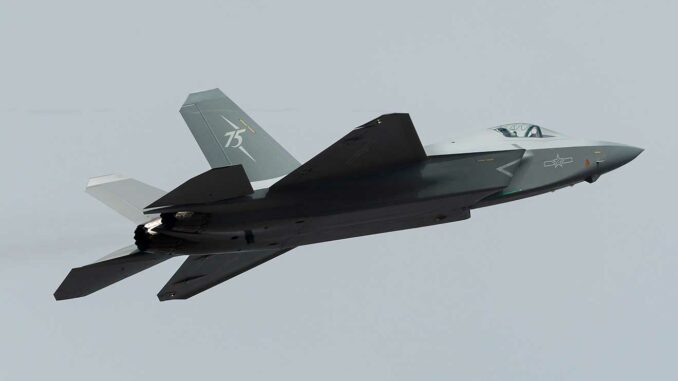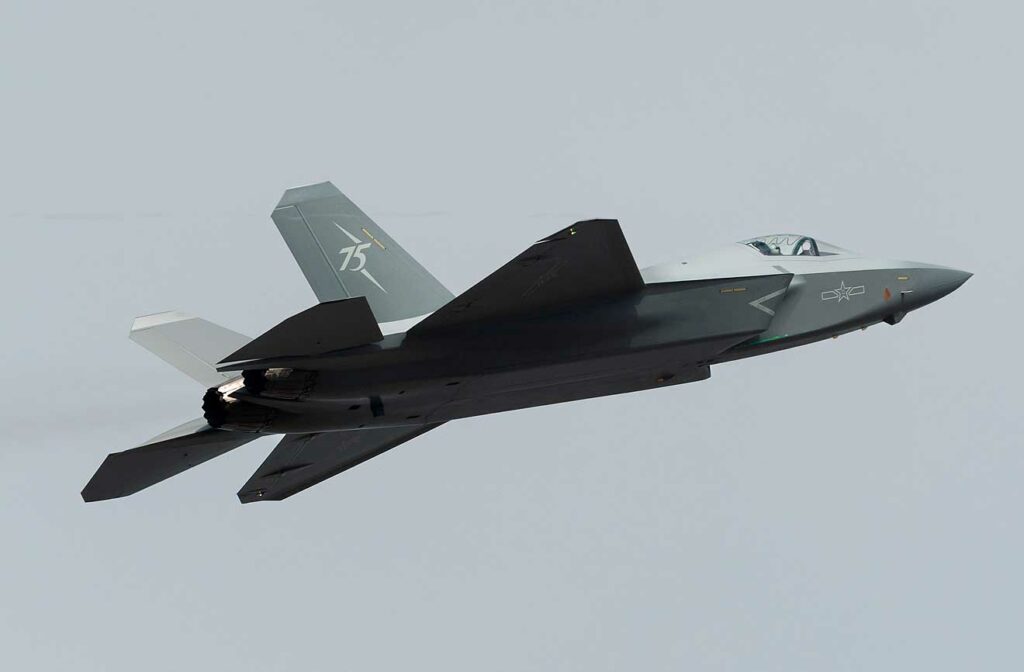
China is deploying the J-35A, its fifth-generation stealth fighter jet, alongside the J-20 and J-16B to take on Western Rafale and F-35 jets.
On July 6, 2025, Beijing confirmed the operational deployment of the J-35A, a fifth-generation Chinese stealth fighter jet designed for both the national air force and the export market. The announcement comes as the People’s Republic of China accelerates the expansion of its military capabilities amid heightened regional tensions in the South China Sea, Central Asia, and the Middle East.
The J-35A, often compared to the US F-35, was developed by Shenyang Aircraft Corporation (SAC). It joins the J-20 and J-16B, the latter two specializing in electronic warfare. The new fighter is armed with PL-15 missiles, which are actively radar-guided and have a range of over 200 kilometers, making it a platform capable of challenging Western air superiority.
This deployment marks a structural change in the organization of the Chinese air force, notably thanks to a doctrine of using interoperable stealth fighters linked to advanced detection systems, unmanned platforms, and a centralized command architecture.
In this article, we analyze the technical characteristics of the J-35A, its strategic positioning, its place in the Chinese military apparatus, and the implications of this deployment for Western air forces, particularly in relation to the French Rafale and the American F-35.
A Chinese fighter jet designed for stealth and export
A cell optimized for radar discretion
The J-35A is an evolution of the FC-31, initially presented as an export demonstrator. The J-35A’s airframe adopts a twin-engine configuration with planar air intakes, a flattened fuselage, an internal weapons bay, and a monocoque canopy designed to limit the frontal radar signature. The coating is believed to be based on a radar-absorbing composite (RAM) similar to that used on the J-20.
The estimated wingspan is 11 meters, with a length of 17 meters and a maximum takeoff weight of over 25 tons. The aircraft would be equipped with an AESA radar, most likely the KLJ-7A, coupled with a nose-mounted electro-optical infrared system, providing passive detection capability.
Designed with a central bay that can carry up to six missiles, the J-35A can remain stealthy in contested environments, but also has four external hardpoints for missions where stealth is secondary. It is intended to integrate into combined operations, combining drones, ISR aircraft, and naval vessels.
A platform designed for the foreign market
Unlike the J-20, developed exclusively for the People’s Liberation Army, the J-35A was designed to appeal to foreign customers, particularly in the Middle East, South Asia, and Africa. Iran, now an operator of the J-10C, could be a future customer, as could Pakistan, which is looking to replace some of its Mirage III/5s still in service.
The price of a J-35A is estimated at €70-80 million, depending on the equipment and support contract. This price, which is lower than that of the Rafale F4 (estimated at over €130 million with armament and support) and the F-35A (around €100 million fully equipped), enables Beijing to make an aggressive technical and operational offer, particularly to states isolated from Western markets.

Integration into an offensive air architecture
A fighter to complement the J-20 and J-16B
The J-35A is not replacing the J-20, but complementing it in other theaters of operation. While the J-20 is deployed for long-range and strategic deterrence missions, the J-35A aims for greater tactical versatility, including naval operations. Several satellite images show its presence at coastal bases, as well as near naval infrastructure in Guangdong and Zhejiang.
The J-16B, equipped with electronic warfare pods and anti-radar missiles, acts as a support and jamming platform, creating a bubble of electromagnetic disruption to facilitate the approach of the J-35As. This synergy mimics the Western concept of the F-35 supported by the EA-18G Growler.
The Chinese doctrine is based on multi-vector coordination, where stealth fighters, drones, and ISR aircraft are integrated into the same tactical network. This enables coordinated attacks beyond the line of sight, with real-time tactical situation sharing.
A centralized, digital command network
The deployment of the J-35A is part of a networked warfare strategy centered on a unified C4ISR command system. This network, which has been in development since 2018, centralizes data flows between fighters, frigates, ground radars, and surveillance satellites. Connectivity is based on a network of encrypted data links and, in some cases, laser or microwave technologies for silent transmissions.
The J-35A was designed to integrate natively into this ecosystem. It receives tactical data, can transmit targeting images to other platforms, and also serves as a mobile communications relay during missions. This approach forces adversaries to deal not with an isolated fighter jet, but with a mobile and distributed combat system.
A direct threat to Western fighter jets
Credible long-range air-to-air capability
The PL-15 missile carried by the J-35A is one of the most worrying components of the system. With a range of over 200 kilometers, it features active radar guidance, supplemented by in-flight correction links. It is a direct rival to the European Meteor, used by the Rafale, and the American AIM-120D.
Recent tests have reportedly validated shots beyond 250 kilometers, although the actual operational range depends on the target’s flight profile. The PL-15 is designed to intercept AWACS aircraft, refuelers, or approaching fighters before they can respond. Combined with the passive stealth capabilities of the J-35A, it enables the Chinese air force to neutralize Western air superiority within an advanced range.
Strategic pressure on the Indo-Pacific and Middle East axes
The introduction of the J-35A into the Chinese battle order comes shortly after the delivery of J-10Cs to Iran, strengthening military ties between Beijing and Tehran. This timing is significant: it extends China’s air projection westward, relying on strategic partners capable of using the same doctrines and equipment.
In the Pacific, the Japanese Self-Defense Forces and the USAF will have to integrate the presence of a new stealth aircraft that is difficult to detect at long range and capable of launching coordinated attacks from decentralized platforms. For France, the Rafale faces increased technological and commercial competition, particularly in regions where military cooperation with China is intensifying.
War Wings Daily is an independant magazine.